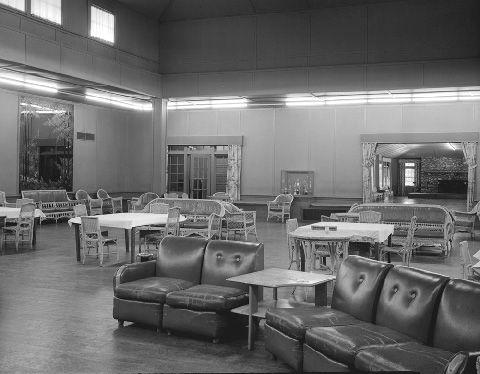
In 1928, still before Price Park was “Price Park”, a chunk of the mature pine forest was torn down. In its place, a building called the Jefferson Pilot Clubhouse was put up. This structure served as a retreat space (hence the name clubhouse) for the employees of the Jefferson Standard Life Insurance Company. Given the time, post Industrial Revolution, it is not surprising that such a mass of natural land was destroyed for the sake of humans. Per modern human tradition, people wanted a space “within the natural world” to retreat, get closer to one another, etc. Of course, they were not actually retreating within the natural world, but rather next to it. They could see it, but not experience it.
Unlike any of the previous human history known about Price Park, these people were not encountering the land in any way, shape, or form. They would likely drive to the space in their cars, go into the building, maybe walk around in the forests every now in then, but ultimately always return to the clubhouse, or their cars, or some other human constructed space. It is a strange thing to think about wanting to retreat in nature, yet at such a distance that you cannot learn about it or experience it. From within a building you are purposely distancing yourself from everything I would associate with the best parts of the natural world. I doubt these retreaters could hear many birdsongs from behind walls, or see much wildlife beyond the windows. They may have had a general knowledge of which trees were which, what flowers were what, and what animal or bird species they may or may not have seen, but I wonder how far this knowledge extended.
For employees of a life insurance company, I am curious to know how their knowledge of the natural world’s life compared to that of human life. Modern medicine had been far advanced since the times of the Revolutionary War and the Underground Railroad, meaning an understanding of medicinal plants was more just a hobby than pertinent information. The ability to get in a car, turn the key, and leave in case of an emergency also shuts down this desire to learn. Of course modern medicine is a good thing, and quick transportation is convenient, but at what cost? Price Park is such a beautiful space of land, with so much complex life within it, that it seems a shame to dismiss it or demean it to a “retreat” — a word that implies connecting with humans and not with the natural world.
The choice to put their building in place of a pine forest goes to show how careless they were. Of course it would have been peaceful to have a manicured space away from constant traffic and other development, but did these people stop to think about the fact that they created what they were trying to escape (a growing industrialized area)? It seems that those who work together likely know enough about each other to not have to go to the clubhouse to mingle — why not have a dinner party or an office gathering every now and then, in a space that has already been built, rather than going through all the time and money to tear down a beautiful and historical chunk of forestry? Why not go to the forest and mingle with the natural elements, rather than with people you see at least five out of the seven days a week.
It is frustrating to me that such a nice space of land was tarnished and destroyed for such a trivial structure. What habitats were destroyed in the process, and what respects were paid to make up for this? Probably many, and none. While it is frustrating, however, it is not in the least surprising. If this hadn’t happened in 1928, it would be sure to have happened later on, given that the land was unprotected and ultimately fair game.